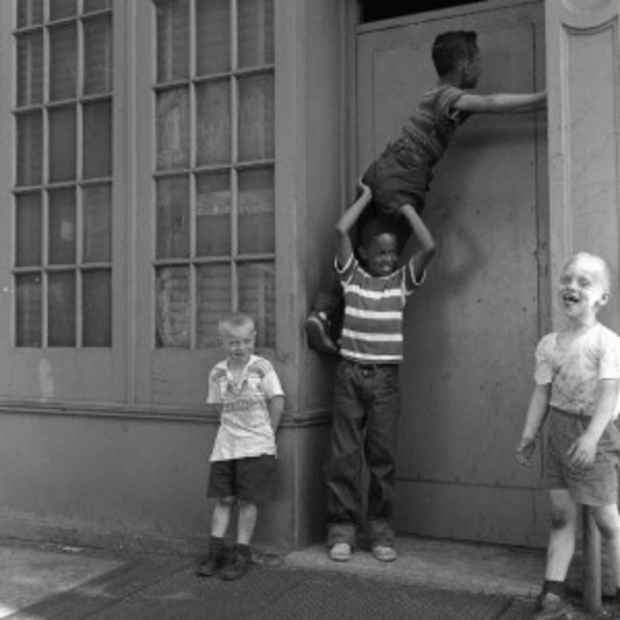Frank Oscar Larson "1950s New York Street Stories"
Queens Museum of Art

This event has ended.
Frank Oscar Larson (1896-1964) was born in Greenpoint, Brooklyn, of Swedish immigrant parents and lived in Flushing, Queens most of his life. As an adult, Larson spent his days at a branch of the Empire Trust Company (now Bank of New York Mellon), working his way up through the ranks from auditor to vice-president, and spare time on weekends taking photographs of street life throughout New York City. He was an accomplished photographer who eloquently documented 1950s Chinatown, the Bowery, Hell’s Kitchen, City Island, Times Square, Central Park, and much more. This exhibition is compiled from thousands of negatives recently discovered stored away in his daughter-in-law’s house in Maine in 2009. Soren Larson, his grandson and a television news camera man and producer, has been scanning and printing the 55 year old images found stored in over 100 envelopes filled with mostly medium format, 2-1/4 x 2-1/4″ negatives, and neatly noted by location and date in Larson’s own hand.
According to Soren Larson, “Photographs dating back to the 1920s attest to the fact that he was always the family shutterbug. But it wasn’t until the early 1950s that Frank’s passion for photography blossomed. By 1949 both of his sons had left home, and perhaps this new situation, no longer having kids at home freed him up on the weekends to delve into photography with a passion.” For the next ten years, weekend expeditions around New York with his beloved Rolleiflex Automat Model 4 camera around his neck, produced thousands of images which he developed in a basement darkroom. Some were printed and entered in photography competitions where he won awards, but most remained undiscovered until the cardboard box of negatives that had been packed away since Frank’s death in 1964, was found.
Larson was an avid, empathetic observer of the life of the streets, and in his eyes, the mundane becomes miraculous. Larson documents the changing face of New York City in Under the El, Park Row, perhaps a subtle self portrait taken in a dramatically composed photograph under the El just prior to its being demolished. Times Square and Chinatown were some of his favorite haunts, at once photogenic and atmospheric, alluring and even alien. Times Square was notoriously illuminated by countless numbers of incandescent light bulbs on the theater marquees and advertising signs. A state of “permanent daylight” made the use of flash unnecessary at night, allowing the photographer to merge into the crowd. Larson achieved a great intimacy and immediacy in unguarded, candid shots such as the evocative, worm’s eye view of Johnny Guitar 1 taken in front of the Brandt’s Mayfair theater showing the film of the same title starring Joan Crawford, and the eerie Ticket Booth at the Brandt Lyric theater, the ticket taker’s face neatly framed in a small round hole in the curved glass booth, masked with dark sunglasses against the blinding lights.
The everyday person is honored in candid portraits of “working stiffs” — policemen, shoe repair men and shoeshine boys, chefs, painters, souvenir and balloon sellers, and husky men hoisting beer barrels – as honest an appraisal of the human condition as any photograph taken by Walker Evans, Atget, Robert Frank, Berenice Abbott or Brassai. In Grand Central Station’s waiting room, a father muses with a doll and boxed gifts next to him on the bench, reveal a solitary moment in the urban maelstrom of rush hour in Midtown. Portraits of children at play in Flushing or Williamsburg recall familiar images by Helen Levitt and Diane Arbus in their fresh directness. Other striking and timeless images such as AP Window show business men huddled in front of the day’s news at the AP Building at Rockefeller Center in 1955, taken just blocks away from Larson’s daily work at the Empire Trust Company, while in School Girls, four pretty young women relax outside in an intimate, almost vulnerable portrait.
Personal memorabilia and family photographs include a charming shot of Larson’s sons, Franklin and David, taken at the Kodak Pavilion at the 1939 New York World’s Fair where they are posed for the “Kodak moment” with a miniature Trylon and Perisphere. Sadly, on the way to visit the New York World’s Fair in 1964, Larson suffered a stroke and passed away, of complications suffered in WWI due to exposure to mustard gas as a young man.
Larson’s own camera equipment – two Rolleiflex Automat Model 4 cameras using 2-1/4 x 2-1/4″ medium format film, lens, filters and light meter, will be included in the exhibition as well.
Media
Schedule
from February 05, 2012 to May 20, 2012
Opening Reception on 2012-02-04 from 18:00 to 22:00